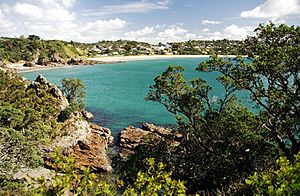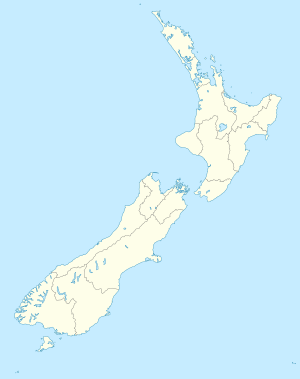Oneroa, New Zealand facts for kids
Quick facts for kids
Oneroa
|
|
|---|---|
|
Suburb
|
|

Oneroa and Oneroa Bay
|
|
| Country | New Zealand |
| Local authority | Auckland |
| Electoral ward | Waitematā and Gulf ward |
| Local board | Waiheke Local Board |
| Area | |
| • Land | 842 ha (2,081 acre) |
| Population
(June 2023)
|
|
| • Total | 1,430 |
| Ferry terminal(s) | Matiatia |
|
|
||
Oneroa is a settlement on Waiheke Island in northern New Zealand.
The New Zealand Ministry for Culture and Heritage gives a translation of "long beach" for Oneroa.
Whittaker's Music Museum, a specialist music museum, has operated in Oneroa since 1996.
Demographics
The statistical area of Oneroa West, which includes the suburb and areas west of it, covers 8.42 km2 (3.25 sq mi) and had an estimated population of 1,430 as of June 2023, with a population density of 170 people per km2.
| Historical population | ||
|---|---|---|
| Year | Pop. | ±% p.a. |
| 2006 | 1,287 | — |
| 2013 | 1,425 | +1.47% |
| 2018 | 1,434 | +0.13% |
Oneroa West had a population of 1,434 at the 2018 New Zealand census, an increase of 9 people (0.6%) since the 2013 census, and an increase of 147 people (11.4%) since the 2006 census. There were 606 households, comprising 699 males and 735 females, giving a sex ratio of 0.95 males per female. The median age was 48.6 years (compared with 37.4 years nationally), with 195 people (13.6%) aged under 15 years, 198 (13.8%) aged 15 to 29, 705 (49.2%) aged 30 to 64, and 339 (23.6%) aged 65 or older.
Ethnicities were 91.2% European/Pākehā, 10.3% Māori, 3.1% Pacific peoples, 3.8% Asian, and 3.6% other ethnicities. People may identify with more than one ethnicity.
The percentage of people born overseas was 34.5, compared with 27.1% nationally.
Although some people chose not to answer the census's question about religious affiliation, 63.2% had no religion, 24.5% were Christian, 0.2% had Māori religious beliefs, 0.2% were Muslim, 0.8% were Buddhist and 2.7% had other religions.
Of those at least 15 years old, 438 (35.4%) people had a bachelor's or higher degree, and 150 (12.1%) people had no formal qualifications. The median income was $36,000, compared with $31,800 nationally. 303 people (24.5%) earned over $70,000 compared to 17.2% nationally. The employment status of those at least 15 was that 588 (47.5%) people were employed full-time, 225 (18.2%) were part-time, and 36 (2.9%) were unemployed.


